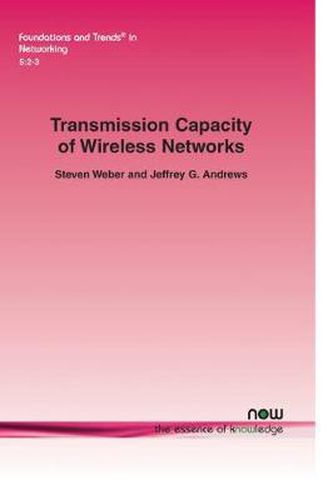Readings Newsletter
Become a Readings Member to make your shopping experience even easier.
Sign in or sign up for free!
You’re not far away from qualifying for FREE standard shipping within Australia
You’ve qualified for FREE standard shipping within Australia
The cart is loading…






This title is printed to order. This book may have been self-published. If so, we cannot guarantee the quality of the content. In the main most books will have gone through the editing process however some may not. We therefore suggest that you be aware of this before ordering this book. If in doubt check either the author or publisher’s details as we are unable to accept any returns unless they are faulty. Please contact us if you have any questions.
Transmission Capacity of Wireless Networks presents a framework for computing the outage probability (OP) and transmission capacity (TC) in a wireless network. Transmission capacity is a performance metric for wireless networks that measures the spatial intensity of successful transmissions per unit area, subject to a constraint on the permissible outage probability (where outage occurs when the SINR at a receiver is below a threshold).
This volume gives a unified treatment of the TC framework that has been developed by the authors and their collaborators over the past decade. The mathematical framework underlying the analysis is stochastic geometry: Poisson point processes model the locations of interferers, and (stable) shot noise processes represent the aggregate interference seen at a receiver. It presents TC results (exact, asymptotic, and bounds) on a simple model in order to illustrate a key strength of the framework: analytical tractability yields explicit performance dependence upon key model parameters. It goes on to present enhancements to this basic model - channel fading, variable link distances, and multi-hop. Chapter 5 presents four network design case studies well-suited to TC: i) spectrum management, ii) interference cancellation, iii) signal threshold transmission scheduling, and iv) power control. Chapter 6 studies the TC when nodes have multiple antennas, which provides a contrast vs. classical results that ignore interference.
Transmission Capacity of Wireless Networks is essential reading for anyone with an interest in wireless network design and in understanding the fundamentals of the performance and behavior of such networks.
$9.00 standard shipping within Australia
FREE standard shipping within Australia for orders over $100.00
Express & International shipping calculated at checkout
This title is printed to order. This book may have been self-published. If so, we cannot guarantee the quality of the content. In the main most books will have gone through the editing process however some may not. We therefore suggest that you be aware of this before ordering this book. If in doubt check either the author or publisher’s details as we are unable to accept any returns unless they are faulty. Please contact us if you have any questions.
Transmission Capacity of Wireless Networks presents a framework for computing the outage probability (OP) and transmission capacity (TC) in a wireless network. Transmission capacity is a performance metric for wireless networks that measures the spatial intensity of successful transmissions per unit area, subject to a constraint on the permissible outage probability (where outage occurs when the SINR at a receiver is below a threshold).
This volume gives a unified treatment of the TC framework that has been developed by the authors and their collaborators over the past decade. The mathematical framework underlying the analysis is stochastic geometry: Poisson point processes model the locations of interferers, and (stable) shot noise processes represent the aggregate interference seen at a receiver. It presents TC results (exact, asymptotic, and bounds) on a simple model in order to illustrate a key strength of the framework: analytical tractability yields explicit performance dependence upon key model parameters. It goes on to present enhancements to this basic model - channel fading, variable link distances, and multi-hop. Chapter 5 presents four network design case studies well-suited to TC: i) spectrum management, ii) interference cancellation, iii) signal threshold transmission scheduling, and iv) power control. Chapter 6 studies the TC when nodes have multiple antennas, which provides a contrast vs. classical results that ignore interference.
Transmission Capacity of Wireless Networks is essential reading for anyone with an interest in wireless network design and in understanding the fundamentals of the performance and behavior of such networks.